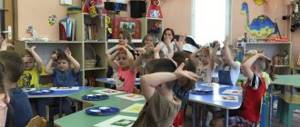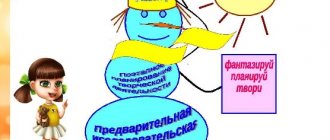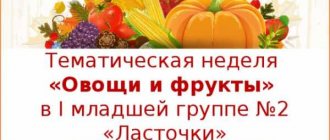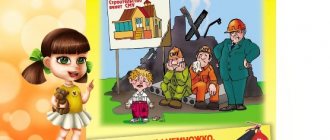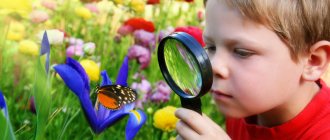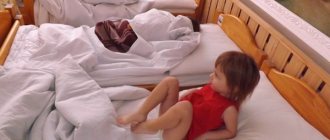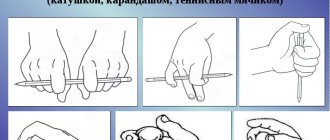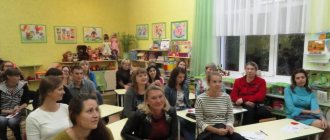Stages and methodological techniques for conducting a lesson
In the middle group, standard long-term planning provides for two application classes per month. The total duration of continuous activity should not exceed 20 minutes; methodological manuals recommend performing physical exercises (finger, breathing, motor exercises) for 2–3 minutes for relaxation and prevention of mental and physical fatigue in children.
Lesson outline
1. Organizational part (3–5 minutes).
The information and familiarization stage involves awakening children's interest in the depicted object, studying its shape, color and components. It is necessary to include game moments that stimulate curiosity, cause a positive emotional reaction and activity. Motivating techniques can be the appearance of a toy character, reliance on a well-known fairy-tale plot, demonstration of pictures, a musical break, a surprise moment, introduction to new knowledge, or the personal artistry of the teacher. It is important to develop the ability to concentrate attention and see an object, to perform its sensory (touch and vision) analysis.
Conversation with children during an application lesson on the topic “We are builders” (author of the summary: Dinara Kireeva)
| Surprise moment. There's a knock on the door. -Oh, guys, someone is knocking on the door. Who is this? D: Pinocchio B: Hello, guys! I brought you a riddle, are you ready to guess it? D: B: Among the clouds on high, We are building a new house together, So that the people in it can live happily in warmth and beauty. (Builder) On the easel, the teacher shows an illustration of a builder. Q: Buratino, our guys know a lot about builders. Sit with us and listen. Conversation about builders Q: What do builders do? D: They build houses, hospitals, kindergartens, shops. Show illustrations. Q: Guys, what professions do you think people build houses? D: Painters, masons, crane operators, carpenters. Show illustrations.
Q: Correct. Painters paint houses, masons make windows, floors, window sills, crane operators work on a crane, lifting loads. — What equipment helps them in building houses? D: Excavator, crane, trucks, roller, bulldozer. Show illustrations.
Q: All people who build houses are called builders. Do you want to become builders (Children's answers) Q: Let's go to the tables, guys, and Pinocchio will come with us and watch us. Physical education break (audio recording) Knock and knock all day, Fist on fist A loud knock is heard. Hands to the sides We are building a house, a big house Hands up And with a porch and a window. Hands in front of the chest We will decorate the house We will paint with our hands We will nail a flag to the top. Finger flag They will live in the house. Show Bunny with a teddy bear and a cat. Knock, knock with a hammer. (Knock fists) We are building, building a new house. (We saw) You drank, drank faster. We are building a house for friends. |
Educational conversation with children
It makes sense to start a conversation of a developing and educational nature with questions about street names, transport, you can take a short interesting excursion into the historical past of the city, remember the sights and monuments that are the calling card, the symbol of your hometown. The lesson will be interesting if the teacher thinks through the game line of the scenario, taking as a basis one of the popular fairy tale plots: the fairy tale “Zayushkina’s Hut”, the poetic fairy tale “Cat’s House”, the adventures of the three little pigs, Uncle Pumpkin’s dream of a house from Gianni Rodari’s literary fairy tale about Cippolino and etc.
Poems and riddles that can be used in lessons about home or city topics.
| Cities are big and small. There are young and old cities. But they move, they burst, they live, and they certainly grow wider and wider. Tell me, who is trying so hard to make cities grow so quickly? And the tall and huge crane is trying! A crane builds a big city, lays slab on slab. This city will be his hometown, When it blossoms with all its might! (T. Saxon) The city is not only the streets and the sky, which is very frowning. The city is also about walks, houses, squares and alleys. In the city, the decoration of the yard is Loud, noisy children! There will always be something for children to do, because cities contain a lot! Some will ride a scooter for a bit, while others will look at the sand. The city is fun for everyone, One walk is already an adventure! (T. Saxon) My house. Look: this is a house - With a roof, a door and a window, And with a porch, and with a chimney, The color of the house is blue. Feel free to come into the house! - Do you invite me? Let's go in! (N. Gol) | Window. Day after day there is a movie on this screen. The sun is full of greenery On the screen in the summer. And in winter the ice turns blue, the snow flies and plays. The film goes on and on and on, without end and edge. (A. Shibaev) Ladder. One - a step, Two - a step, Three - a bruised knee. On the fourth step I get up on all fours. Let the steps be high, High, There are bruises on the knees, Bruises. I climbed the stairs, the rest is nothing! (A. Akhundova) Roof. If there is a roof and there is a ladder, you can climb onto the roof of the floor of the ladder. You can run around on the roof later, And you can lie down and fall apart. Everything is possible. We must not forget that you can fall off the roof! (V. Danko) | My relatives live in it, I can’t live a day without them. I strive for it always and everywhere, I will not forget the road to it. I can hardly breathe without him, My home, dear, warm... (Home) They didn't sleep all day, They played tag with the sun, The sunbeams were jumping like balls. And when night came, they went to bed tiredly and covered themselves with a blanket. (Windows with curtains) He stands, simple and strict, In a plain jacket, He has many pockets, Wires in his hand, And his eyes, like saucers, Either go out or blink. And He tries to reach the sky with His hands. (House with balconies) Mushrooms have been born with one sprout, they stand along the path, their backs are straight, the old mushroom breaks, a new one grows. (Street with houses) The houses stand in two rows - Ten, twenty, a hundred in a row, And they look at each other with square eyes. (Street) |
2. The practical stage includes an explanation and demonstration by the teacher of a step-by-step algorithm for laying out and gluing elements (2-3 minutes).
The level of development of children's spatial thinking does not yet allow them to independently determine the location of a part in the composition of a pattern or the correct location of the component part of an object, so the teacher needs to clearly demonstrate and explain the sequence of completing the task. Unfamiliar operations require additional explanation and demonstration, for example, cutting off the corners of a rectangle to obtain a trapezoidal roof shape; children cut out familiar shapes (rectangle and square) on their own. Increased attention is paid to work culture, careful and safe handling of scissors, for which it is advisable to divide children into subgroups of up to seven people while learning how to properly work with a new tool. Children must learn to confidently hold scissors and make movements with them that will not wrinkle the paper.
The teacher works with the children
3. Independent work of children (15 minutes).
After carefully listening to the teacher’s explanations, the children cut out the parts and glue them to the base in accordance with the assignment. The teacher monitors the correctness of the task; it is advisable to prepare all the necessary equipment and preparations on the work tables in advance.
4. Analysis and summing up (2–3 minutes).
The final stage of the lesson takes place in the form of an exhibition of children's works, the teacher teaches them to joyfully perceive their own and other people's successes, conducts an analysis, accompanying it with praise for their efforts and hard work, discusses with the children the degree of accuracy of the work (clear and even edges, absence of traces of glue), and also the correspondence of the image created by the child to the original or sample, marks successful creative ideas and original experiments.
Lesson notes
In the lesson scenario, the teacher indicates goals and objectives. In the process of planning, organizing and conducting applique classes in the middle group, they usually focus on solving the following problems:
- Mastering the skills of working with scissors, glue and colored paper, learning to design from pieces of cotton wool, fabric, leaves on a cardboard or paper base, using plasticine.
- Development of independence and creative initiative in determining the plot or genre (object painting, landscape) of the application.
- Developing the ability to hear and understand musical or poetic accompaniment that sounds during the performance of a creative task. Such an interesting combination of various methods of emotional and artistic instruments of influence is aimed at achieving the comprehensive aesthetic development of children, the formation of artistic taste and a sense of beauty.
Lesson notes on application on the topic “City of Friendship” (based on N. Parsova’s notes)
Tasks:
- teach students to cut out several identical parts from a strip (windows of a house, roofs of houses, strips for a pedestrian crossing);
- place windows at one line level;
- develop composition skills;
- awaken cognitive interest in the world around us, love for our small homeland;
- develop the ability to work cooperatively in a team.
1. An introductory conversation that is woven into the game situation. You can use visual material, for example, photographs or pictures depicting streets, architectural landmarks of your hometown, which will be easily recognized by children and will evoke a positive emotional mood.
| Introduction to the game situation. Educator: Guys, today a letter arrived in our kindergarten. Let's see who wrote it to us: “Hello, dear children of the middle group.” I need your help. Our friends' house became very small and the roof was leaky, there was not enough space for our friends. Help us please, we don't know what to do? My friends Crocodile Gena, old woman Shapoklyak, Giraffe, Leo will be very grateful to you.” Guys, who do you think the letter is from? That's right from Cheburashka. (Cartoon picture). Well, guys, how can we help? What to do? (Conversation with children) Children: “We will help build new houses.” Updating knowledge. Educator: - What do you think needs to be done before starting to build a house? — How should the house cost, what is it made of? (conversation) - What building materials are they made of? How many materials are needed for a home? (Children's expected answers). — What do you guys think, what should houses be like? (Durable, warm, single-story, multi-story, high, low) - What should the roof be like? (Waterproof, durable) Difficulty in a gaming situation. Educator: - Well, how do we decide what kind of houses we need? - Who can help us, do you think? (Children's answers) - Where can I find out? (Children's answers). First you need to choose a place to build a house. Okay, what next (conversation). Discovery of new knowledge. — Guys, who do you think comes up with what a house should be like? (Architect). Look, the architect has a special table with many different rulers, and with their help he draws a drawing of the house. -Who do you think will help build the house next? (Engineer) - What does an Engineer do? The engineer calculates how much building material needs to be brought to the construction site to build a durable house. And then (who?) the builders work on the drawings. — What construction professions do you know? (masons, carpenters, painters, crane operator). — Guys, you see how many professions are involved in building a house. |
2. Practical part. The teacher draws the children's attention to a sheet of Whatman paper prepared in advance with some glued and drawn elements of the future composition, for example, a road, one house, a tree. Then the teacher invites the children to complete the picture, completing it with the missing figures and silhouettes, and to complete the details of houses and cars with pencils.
The teacher explains and shows techniques and methods for making appliqué parts.
— We take a strip of paper, fold it several times, then lay it out and cut along the fold lines, so we get windows. If the sheet is folded in half and then cut, you will get the walls of houses. Rectangles, the corners of which are cut off at the top, turn into roofs.
- You must “build” new beautiful and cozy houses for Crocodile Gena’s friends, “plant” trees. Cars and trucks will drive along the roads of our city (the teacher prepares the silhouettes of trees and cars in advance).
3. Children work independently. The teacher helps and prompts as necessary, controls the work with scissors and glue.
Teamwork of children
4. Summing up.
“There are so many beautiful houses on our street; happy, friendly families, adults and children, will live in them. All our houses are cozy, warm and welcoming. You guys are great!
Ready composition
Lesson summary on the application “Teremok”
Tasks:
- Remind the children of the content of the fairy tale “Teremok”.
- Develop children's speech activity.
- Instill interest in Russian folk tales.
- Strengthen the ability to use a brush, carefully glue ready-made forms.
- Cultivate a caring attitude towards animals.
Preliminary work : Reading fairy tales, looking at illustrations, solving riddles about animals, showing theater on a flannelgraph and on a screen, coloring characters. Conducting games and exercises: “Say kindly”, “What shape?”, “What color?”, “What is round (square, triangular, rectangular”, “What is green (red, yellow, blue)?”).
Equipment : sheets of paper for illustrations, colored paper of ready-made shapes for the house (square and triangle), silhouettes of animals, trees and other attributes. Glue, brushes, rags, files for a book.
Progress of the lesson:
Educator: Children, look, what is this unusual chest on the table? Do you want to see what's there? (takes out toys, children name) Correctly, these are animals: mouse, frog, bunny, fox, wolf, bear.)
Educator: What is the name of the fairy tale in which there are all these heroes? (children's answers).
And what were they called affectionately, fabulously?
Children: Bunny - runaway, little mouse, frog - croak, top - gray barrel, fox - little sister, Mikhailo Potapych.
That's right, the fairy tale is called "Teremok". What happened at the end of this fairy tale?
Children: The bear broke the tower and all the animals fled, and then the animals all built a new house together.
Educator: Well done. Let us make a book ourselves based on the fairy tale “Teremok”. On your table are pieces of paper for the page of our book, colored paper and figures of animals, bushes and trees. Look at the yellow paper. What shape is it?
Children: Square.
Educator: This will be our house. What shape is black paper?
Children: Triangular in shape.
Educator: What do you think it looks like?
Children: On the roof.
Educator: That's right, it will be the roof. Let's assemble a little tower on some leaves. First we put a square and a triangle on top. What did we get? (children's answers)
Now we will carefully glue it.
Whoever glued the tower can choose any animal that will live in your tower.
Where do these animals live?
Children: In the forest.
Educator: Yes, these are wild animals, they live in the forest, so we need to glue Christmas trees, bushes, and grass near the house. We will paste the sun and clouds onto the sky. I also made a page for our book.
Look how many beautiful, bright pages we have created!
Now let's collect the book. Who ran to the tower first? Who's second? Who next? (children's answers)
And I did the last page. What is shown here? (children's answers)
And on the last page the animals all together built a new large mansion. There's enough room for everyone. Look, we have a real book. What is it called? (children's answers)
That's right, the fairy tale is called "Teremok". And the pages for this fairy tale we
we did it together, together. That's why we got an interesting
book. Did you enjoy making the book? Next time, you and I will make a book ourselves for a different fairy tale. And now we will look at our little book (examination and discussion of pictures).
